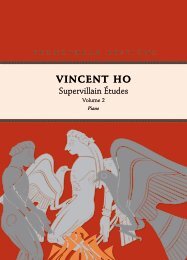You also want an ePaper? Increase the reach of your titles
YUMPU automatically turns print PDFs into web optimized ePapers that Google loves.
In 1947 Lilburn joined the staff at Victoria University College in Wellington and completed several<br />
works that received high critical acclaim, including two symphonies, two piano sonatas, and the<br />
Alistair Campbell song cycle Elegy (1951) – a vision of the titanic indifference of nature.<br />
Lilburn composed the Symphony No.3 (1961), along with Sonatina No.2 (1962) and Nine Short<br />
Pieces for <strong>Piano</strong> (1965–66), in response to a stimulating period of sabbatical leave. Masterpieces of<br />
concentrated form, these works explore the boundaries of his instrumental writing. From this point<br />
until his retirement, Lilburn chose to take on the new territory of electroacoustic composition.<br />
Lilburn’s final years were spent quietly at home in Thorndon, Wellington, tending to his garden and,<br />
until the onset of arthritis, playing his beloved August Förster piano. He received the Order of New<br />
Zealand in 1988.<br />
Prelude (1951)<br />
This piece, which has a Bachian feel for harmonic movement, has aptly been described by the pianist<br />
Margaret Nielsen as ‘exuding a sort of rhapsodic nostalgia as each phrase struggles to escape from<br />
the pedal points that act as secure anchors to different tonal areas.’ A surge of sound in the middle<br />
releases the music into a new tonal centre of C sharp minor but shifting tonalities ensue until it<br />
finally resolves into D major. Lilburn is spare with performing instructions but, as a general rule in<br />
pieces like this, one aims for clearness and plasticity of sound.<br />
Five Bagatelles (1942)<br />
Allegro<br />
Largo<br />
Allegro con brio<br />
Tranquillo (‘From the Port Hills’)<br />
Allegro<br />
The musical structure as one moves through this set progressively reveals a larger unity. The fourth<br />
prelude is known independently as ‘From the Port Hills’, which is a topographical reference to the<br />
Christchurch landscape; the hushed chords and ambient modalities create a warming nimbus, and<br />
this special envelope of sound sustains from first to last. Noel Newson premiered Five Bagatelles<br />
on 12 December 1942 at a concert presented by the Royal Christchurch <strong>Music</strong>al Society (he gave<br />
a repeat performance at a concert devoted to Lilburn’s music held in the Canterbury University<br />
College Hall on 29 September 1943). A recording of Lilburn playing ‘From the Port Hills’ exists in<br />
the National Sound Archives.<br />
‘Three Pieces’ (1965)<br />
These pieces reveal the erudition of Lilburn’s serial technique but, just as in his Third Symphony,<br />
this is not serialism for the sake of serialism but serialism to invite another dimension. The last piece<br />
is a marvel of sustained intensity and it is wonderfully instructive to see how Lilburn varies the limpid<br />
sonorities emanating from the opening bars to create an even more transfixing beauty.<br />
PEL07 – v


















